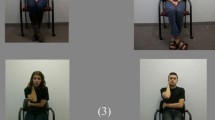Abstract
Twenty Asperger’s Syndrome (AS) participants were compared with 20 matched neurotypical controls in their decoding of postural cues of boredom, interest, and disagreement. On a nonverbal matching task, the AS group performed as accurately as the controls, whereas on a verbal labeling task, AS participants made significantly more mistakes in labeling bored postures. Response times of the AS group were significantly slower than controls in their judgments of all three attitudes on both tasks, with the exception only of disagreeing postures on the verbal labeling task. It was hypothesized that these slower response times may reflect a feature-based cognitive processing style by AS participants. Proposed practical recommendations are to train AS individuals in the recognition of boredom, and to improve the speed with which they can recognize different attitudes.

Similar content being viewed by others
References
Adolphs, R., Sears, L., & Piven, J. (2001). Abnormal processing of social information from faces in autism. Journal of Cognitive Neuroscience, 13, 232–240.
American Psychiatric Association. (2000). Diagnostic and statistical manual of mental disorders (4th edn.)-TR. Washington, DC: American Psychiatric Association Press.
Ashwin, C., Wheelwright, S., & Baron-Cohen, S. (2006). Attention bias to faces in Asperger syndrome: A pictorial emotion stroop study. Psychological Medicine, 36, 835–843.
Atkinson, A. P. (2009). Impaired recognition of emotions from body movements is associated with elevated motion coherence thresholds in autism spectrum disorders. Neuropsychologia, 47, 3023–3029.
Baron-Cohen, S. (1995). Mindblindness: An essay on autism and theory of mind. Boston: MIT Press/Bradford Books.
Baron-Cohen, S., Jolliffe, T., Mortimore, C., & Robertson, M. (1997). Another advanced test of theory of mind: Evidence from very high functioning adults with autism or Asperger syndrome. Journal of Child Psychology and Psychiatry, 38, 813–822.
Behrmann, M., Avidan, G., Leonard, G. L., Kimchi, R., Luna, B., Humphreys, K., et al. (2006). Configural processing in autism and its relationship to face processing. Neuropsychologia, 44, 110–129.
Betts, S. W., Betts, D. E., & Gerber-Eckard, L. N. (2007). Asperger syndrome in the inclusive classroom: Advice and strategies for teachers. London: Jessica Kingsley Publishers.
Bull, P. (1987). Posture and gesture. Oxford: Pergamon.
Carrington, S., & Graham, L. (1999). Asperger’s syndrome: Learner characteristics and teaching strategies. Special Education Perspectives, 8(2), 15–23.
Clements, J., & Zarkowska, E. (2000). Behavioural concerns and autistic spectrum disorders: Explanations and strategies for change. London: Jessica Kingsley.
Ekman, P. (1992a). Are there basic emotions? Psychological Review, 99, 550–553.
Ekman, P. (1992b). An argument for basic emotions. Cognition & Emotion, 6(3), 169–200.
Ekman, P. (1994). Strong evidence for universals in facial expressions: A reply to Russell’s mistaken critique. Psychological Bulletin, 115(2), 268–287.
Ekman, P. (1999). Basic emotions. In T. Dalgleish & M. Power (Eds.), Handbook of cognition and emotion (pp. 45–60). Sussex, UK: Wiley.
Folstein, S. E. (2006). The clinical spectrum of autism. Clinical Neuroscience Research, 6, 113–117.
Frank, M. G., & Stennett, J. (2001). The forced-choice paradigm and the perception of facial expressions of emotion. Journal of Personality and Social Psychology, 80(1), 75–85.
Frith, U., & Happé, F. (1994). Language and communication in autistic disorders. Philosophical Transactions of the Royal Society of London, B, 346, 97–104.
Gillberg, C., Cederlund, M., Lamberg, K., & Zeijlon, L. (2006). The autism epidemic. The registered prevalence of autism in a Swedish urban area. Journal of Autism and Developmental Disorders, 36, 429–434.
Golan, O., Baron-Cohen, S., & Hill, J. (2006). The Cambridge mindreading (CAM) face-voice battery: Testing complex emotion recognition in adults with and without Asperger syndrome. Journal of Autism and Developmental Disorders, 36(2), 169–183.
Grossman, J. B., Klin, A., Carter, A. S., & Volkmar, F. R. (2000). Verbal bias in recognition of facial emotions in children with Asperger syndrome. Journal of Child Psychology and Psychiatry and Allied Disciplines, 41, 369–379.
Hadjikhani, N., Joseph, R. M., Manoach, D. S., Naik, P., Snyder, J., Dominick, K., et al. (2009). Body expressions of emotion do not trigger fear contagion in autism spectrum disorder. Social Cognitive and Affective Neuroscience, 4(1), 70–78.
Happé, F. (1994). An advanced test of theory of mind: Understanding of story characters’ thoughts and feelings by able autistic, mentally handicapped, and normal children and adults. Journal of Autism and Developmental Disorders, 24, 129–154.
Happé, F. (1995). The role of age and verbal ability in the theory of mind task performance of subjects with autism. Child Development, 66(3), 843–855.
Hawkins, G. (2004). How to find work that works for people with Asperger’s syndrome. London: Jessica Kingsley Publishers.
Hobson, R. P., Ouston, J., & Lee, A. (1988). What’s in a face? The case of autism. British Journal of Developmental Psychology, 79, 441–453.
Hubert, B., Wicker, B., Moore, D. G., Monfardini, E., Duverger, H., Da Fonseca, D., et al. (2007). Recognition of emotional and non-emotional biological motion in individuals with autistic spectrum disorders. Journal of Autism and Developmental Disorders, 37, 1386–1392.
Kätsyri, J., Saalasti, S., Tiippana, K., von Wendt, L., & Sams, M. (2008). Impaired recognition of facial emotions from low-spatial frequencies in Asperger syndrome. Neuropsychologia, 46, 1888–1897.
Kleinman, J., Marciano, P. L., & Ault, R. L. (2001). Advanced theory of mind in high-functioning adults with autism. Journal of Autism and Developmental Disorders, 31, 29–36.
Klin, A. (2006). Autism and Asperger syndrome: An overview. Revista Brasileira de Psiquiatria, 28(1), 3–11.
Krug, D. A., & Arick, J. R. (2003). Krug Asperger’s disorder index. Austin, Texas: Pro-Ed Inc.
Lindner, J. L., & Rosén, L. A. (2006). Decoding of emotion through facial expression, prosody and verbal content in children and adolescents with Asperger’s syndrome. Journal of Autism and Developmental Disorders, 36, 769–777.
McKinnon, M. C., & Moscovitch, M. (2007). Domain-general contributions to social reasoning: Theory of mind and deontic reasoning re-explored. Cognition, 102, 179–218.
Miller, J. N., & Ozonoff, S. (2000). The external validity of Asperger disorder: Lack of evidence from the domain of neuropsychology. Journal of Abnormal Psychology, 109, 227–238.
Moore, D. G. (1997). Components of person perception: An investigation with autistic, non-autistic retarded and typically developing children and adolescents. British Journal of Developmental Psychology, 15, 401–423.
Painter, K. K. (2006). Social skills groups for children and adolescents with Asperger’s syndrome. London: Jessica Kingsley Publishers.
Parron, C., Da Fonseca, D., Santos, A., Moore, D. G., Monfardini, E., & Deruelle, C. (2008). Recognition of biological motion in children with autistic spectrum disorders. Autism, 12(3), 261–274.
Pasch, M., & Poppe, R. W. (2007). Person or puppet? The role of stimulus realism in attributing emotion to static body postures. In Proceedings of the conference on affective computing and intelligent interaction (ACII), 12–14 September 2007, Lecture Notes in Computer Science: Vol. 4738 (pp. 83–94). Lisbon, Portugal: Springer.
Philip, R. C. M., Whalley, H., Stanfield, A. C., Sprengelmeyer, R., Santos, I. M., Young, A. W., et al. (2010). Deficits in facial, body movement and vocal emotional processing in autism spectrum disorders. Psychological Medicine, 40(11), 1919–1929.
Pohlig, R. L. (2008). Nonverbal sensitivity in individuals with autism spectrum disorders. Poster session presented at the annual International Meeting for Autism Research, London.
Reed, C. L., Beall, P. M., Stone, V. E., Kopelioff, L., Pulham, D. J., & Hepburn, S. L. (2007). Perception of body posture—what individuals with autism spectrum disorder might be missing. Journal of Autism and Developmental Disorders, 37, 1576–1584.
Reynolds, C. R., Pearson, N. A., & Voress, J. K. (2002). Developmental test of visual perception–adolescent and adult. Austin, TX: Pro-Ed.
Roid, G. H. (2003). Stanford-Binet intelligence scales (5th ed.). Itasca, IL: Riverside Publishing.
Rondan, C., & Deruelle, C. (2007). Global and configural visual processing in adults with autism and Asperger syndrome. Research in Developmental Disabilities, 28, 197–206.
Russell, J. A. (1993). Forced-choice response in the study of facial expression. Motivation and Emotion, 17, 41–51.
Russell, J. A. (1994). Is there universal recognition of emotion from facial expressions? A review of the cross-cultural studies. Psychological Bulletin, 115, 102–141.
Rutherford, M. D., Baron-Cohen, S., & Wheelwright, S. (2002). Reading the mind in the voice: A study with normal adults and adults with Asperger’s syndrome and high functioning autism. Journal of Autism and Developmental Disorders, 32, 189–194.
Scheuffgen, K., Happé, F., Anderson, M., & Frith, U. (2000). High “intelligence”, low “IQ”? Speed of processing and measured IQ in children with autism. Development and Psychopathology, 12, 83–90.
Wallace, S., Coleman, M., & Bailey, A. (2008). An investigation of basic facial expression recognition in autism spectrum disorders. Cognition and Emotion, 22(7), 1353–1380.
Winters, A. (2005). Perceptions of body posture and emotion: A question of methodology. The New School Psychology Bulletin, 3, 35–45.
Woodcock, R. W., Schrank, F. A., Mather, N., & McGrew, K. S. (2007). Woodcock-Johnson III tests of achievement, Form C/Brief Battery. Rolling Meadows, IL: Riverside Publishing.
Author information
Authors and Affiliations
Corresponding author
Rights and permissions
About this article
Cite this article
Doody, J.P., Bull, P. Asperger’s Syndrome and the Decoding of Boredom, Interest, and Disagreement from Body Posture. J Nonverbal Behav 35, 87–100 (2011). https://doi.org/10.1007/s10919-010-0103-0
Published:
Issue Date:
DOI: https://doi.org/10.1007/s10919-010-0103-0




